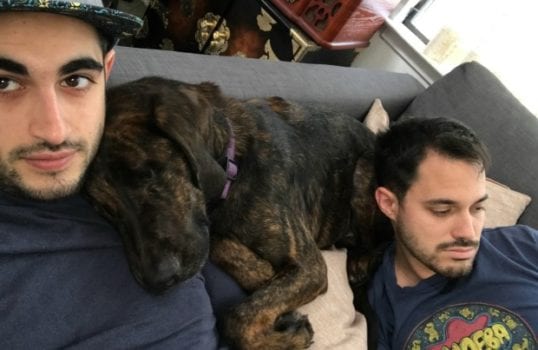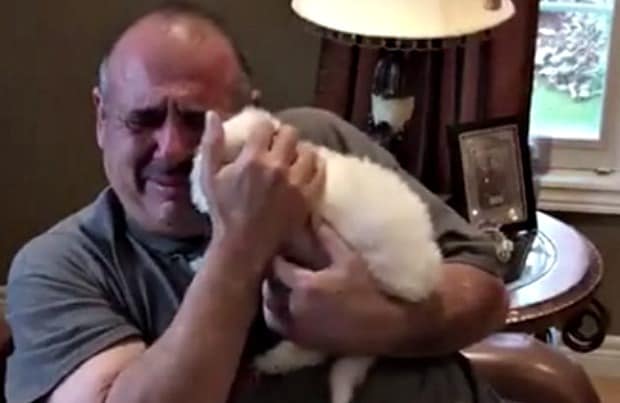Ray, a young Plott Hound found tied to a post without food or water, suffered a great deal at a young age. He arrived at the San Francisco SPCA in July of 2016 at just a year old with inflamed, irritated eyes, making it difficult for him to see. The veterinary team who attended to Ray decided that it was best to give him a bilateral enucleation. Without his eyes, Ray was blind. Judging how Ray affected the people around him, however, not having his eyesight didn’t slow him down once in the shelter. “Ray was such a happy-go-lucky dog and the staff loved him,” says San Francisco SPCA media manager Krista Maloney.
Ray loved to play, but not with the dog toys that dogs usually do because he couldn’t see what they were. Instead, he loved to chase a broom used to sweep up the shelter. He loved it so much, Amber Eby, the San Francisco SPCA adoption manager, says that they purchased a brand new broom as a toy for Ray (even though he much preferred the original one). “He probably liked the smell of the first broom since it was used for sweeping dog food,” she says.
Even visitors who came to the shelter were taken by Ray’s sweet disposition, and a family vacationing in the city donated the $150 adoption fee for Ray’s future owners. It wasn’t long until Ray met the people who would become his forever family.
Meeting His Forever Family
Lee Medvedoff and Joe Schiro went to the shelter in August of 2016 with no real intention of picking up a dog. They saw Ray and had some reservations (he had kennel cough and they were worried about his blindness), but couldn’t help fall in love with him. “He was super friendly and none of the other dogs were as affectionate as he was,” says Schiro.

Because Medvedoff also happens to be a high school special education teacher who has worked with blind students, the couple felt equipped to handle a dog who couldn’t see. “In the end, Ray being blind just made us love him even more,” he says.
However, life with Ray didn’t start free of obstacles. It did take a few months for Ray to transition to life at home, and at first, Ray would attempt to take his new parents’ food due to the deprivation he experienced early in life.
“It was a little frustrating at first,” shares Medvedoff. But with time, the Plott Hound learned not to eat off his caretakers’ plates. He now even knows a range of commands, including sit, stay and down.
Similar to his experience in the shelter, Ray’s blindness doesn’t allow him to easily distinguish between a shoe that seems perfect for chewing versus a dog toy that was meant for him. Medvedoff and Schiro taught Ray to differentiate between the two by creating a place specifically for his playthings. “Ray has a toy milk crate he goes to when he wants to pull out toys to play,” says Medvedoff.

Life with Ray
In the busy San Francisco neighborhood where Ray resides with Schiro and Medvedoff, he’s become well-known and recognizable. The only blind dog in the area who rivals other pooches for the title of happiest disposition, Ray gets a lot of attention when out and about. “People we see spoil him with dog treats,” says Schiro.
According to Schiro, Ray loves to be held. Because he can’t see, it’s especially important for him to use his sense of touch. “He’s a big cuddler and just loves to lay and lean on us.”
Ray has definitely had a positive effect on his pet parents. For Schiro, it’s the community of dog lovers he’s been able to meet because Ray is such a people and pooch-friendly hound. Medvedoff expresses a similar sentiment. “Having Ray has taught me to be more mindful of the present, and that’s nice,” he adds.
Both Schiro and Medvedoff agree that Ray doesn’t let his inability to see hamper him. According to Medvedoff, one might expect Ray’s blindness to slow him down, but instead, the hound plows full speed ahead when he walks and doesn’t mind bumping into things.
It’s possible that Ray has something to teach everyone he encounters: that you shouldn’t let early difficulties in life or a perceived physical impairment stop you from living with the same exuberance that he does.

Christina Chan covers a range of topics from health and wellness to pets. She’s fortunate to have her canine companion, Ellie the pug, snoring by her side during writing sessions.
Share:









